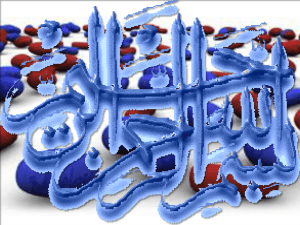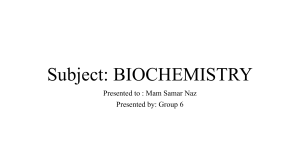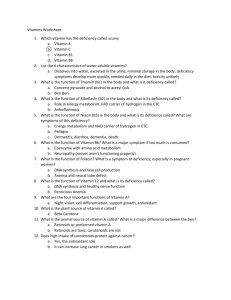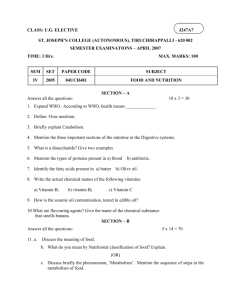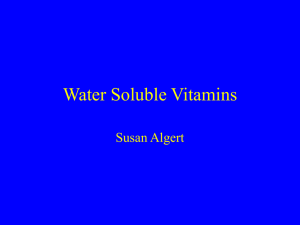Deficiency
advertisement
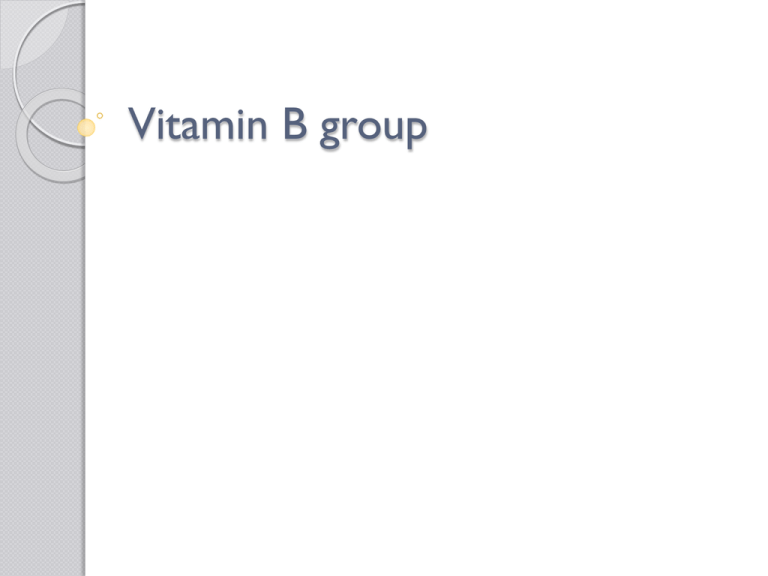
Vitamin B group A group of water-soluble vitamins that characteristically serve as components of coenzymes. Plants and many microorganisms can manufacture B vitamins but dietary sources are essential for most animals. Heat and light tend to destroy B vitamins. The vitamin B complex consists of 12 related substances. Eight are considered essential vitamins because they need to be included in the diet. Four are not essential because the body can synthesize them. They include thiamin (B1), riboflavin(B2), niacin, vitamin B6, pantothenic acid, folic acid, biotin and vitamin B12 (cobalamin); some authorities also include choline, lipoic acid, inositol, and paraaminobenzoic acid. Although these vitamins are chemically distinct, they are grouped together because they are found with one another in the same foods. B1; or Thiamin Function It is an organic compound of two parts contains sulphur and nitrogen. Antineuritic vitamin Destroyed by alkaline and heat Precursor of the coenzyme thiamine pyrophosphate (TPP), which functions in carbohydrate metabolism. is essential to normal nerve function and the utilization of carbohydrates Stimulate" the appetite Prevent and "cure" beriberi, or multiple neuritis, characterized by inflammation and degeneration of the peripheral nerves, intense pain, resulting, finally, in paralysis and wasting of the muscles. • Deficiency • first symptoms of B1 deficiency is loss of appetite. • Beriberi (which can cause weakness, leg spasms, poor appetite, and loss of coordination.) muscle spasm include heart • In alcoholic result in Wernicke-Korsakoff syndrome( mental confusion, staggering, rapid eye movement or paralysis of eye muscle.) • Sources: Wheat germ, beans, peas, and green vegetables Meat Sunflower seeds RDA Men: 1.2 mg Women: 1.1 mg Requirement increases with energy expenditure Toxicity: none known B2 or riboflavin Functions composed of a single type of sugar (ribose) and a yellow pigment (flavin) first discovered in milk and also been called lactoflavin. It is a constituent of the coenzymes FAD and FMN, which have an important role in the metabolism of all major nutrients as well as in the oxidative phosphorylation reactions of the electron transport chain.(Kreb’s cycle Flavin mononucleotide (FMN) Flavin adenine dinucleotide (FAD) Deficiency -Skin lesions, especially cheliosis, or fissures in the corners of the mouth and tongue -Bloodshot eyes RDA Men: 1.3 mg Women: 1.1 mg Toxicity: none known Sources: Milk/products Enriched grains Liver Mushroms green vegatbles Brewer’s yeast -Sensitive to uv radiation (sunlight) B3; Niacin Functions Nicotinic acid Other forms of vitamin B3 nicotinamide Can be made from the essential amino acid tryptophan precursor to NADH, NAD+, NADP+ and NADPH, which play essential metabolic roles in living cells. In larger doses, niacin can reverse atherosclerosis by lowering low density lipoprotein (LDL) Nicotinamide adenine dinucleotide (NAD) Nicotinamide adenine dinucleotide phosphate (NADP) Deficiency Pellagra is characterized by diarrhea, dermatitis and dementia as well as “necklace” lesions on the lower neck, hyperpigmentation, thickening of the skin, inflammation of the mouth and tongue, digestive disturbances, amnesia, delirium, and eventually death, if left untreated[ Dietary niacin deficiency tends to occur in areas where people eat maize("corn") as a staple food. Maize is the only grain low in niacin( nixtamalization is needed) Sources: Mushrooms Enriched grains Beef, chicken, turkey, fish Heat stable; little cooking loss RDA Men: 16 mg equivalents Women: 14 mg equivalents Body can make niacin from tryptophan skin flushing and itching Gastrointestinal Toxicity complaints such as dyspepsia (indigestion) and liver toxicity B5; Pantothenic acid needed to form coenzyme-A (CoA and is critical in the metabolism and synthesis of carbohydrates, proteins, and fats. PantothenicGreek word meaning "from everywhere: widely distributed Deficiency: rare. Biotin functions described as the most powerful of all the vitamins Names: vitamin H, a second called it biotin and a third called it "coenzyme R," Necessary for cell growth, the production of fatty acids, and the metabolism of fats and amino acids. Need for carboxylation reactions Recommended for strengthening hair and nails Need to make glycogen Deficiency: Rare Depression Numbness/tingling in arms and legs skin rash, hair loss, convulsion, neurological disorders, impaired growth in children Sources: Widespread in food Cheese, egg yolk, liver, peanut butter, soybeans, fish Synthesized by GI bacteria Adequate Intake is 30 ug/day for adults This may overestimate the amount needed for adults No Upper Limit for biotin Vitamin B6 or pyridoxine Functions Other names • Pyridoxine • Pyridoxal • Pyridoxamine Destroyed by heat It is a constituent of a coenzyme (pyridoxal phosphate) involved in amino acid metabolism. assists in the balancing of sodium and potassium. promote red blood cell production Synthesize sertonin, histamine, epinephrine and norepinephrine Conversion of tryptophan to niacin • Deficiency : • Microcytic anemia • causes retarded growth. • dermatitis. Convulsions • Sources: • • • • Meat, fish legume Seeds and nuts Liver Noncitrus fruit RDA – 1.3 mg/day for adults – 1.7 mg/day for men over 50 – 1.5 mg/day for women over 50 • Athletes may need more • Alcohol increases vitamin B-6 destruction Toxicity• Irreversable nerve damage, numbness in hands feet • Difficult of work, Convulsion, Restlessness and • Insomnia. Folic acidB9 or folacin Function Essential for synthesis of DNA, repair DNA, and methylate DNA Important during periods of rapid cell division and growth. Breakdown homocysteine May reduce risk of some cancer as breast and pancreatic cancers. folate (the naturally occurring form), Folic acid is itself not biologically active, but its biological importance is due to tetrahydrofolate and other derivatives after its conversion to dihydrofolic acid in the liver Deficiency Neural tube in developing embryos. DNA synthesis and repair are impaired and this could lead to cancer development Megaloblastic anemia Sources: 400 ug/day for adults Liver Fortified breakfast cereals Grains, legumes Foliage vegetables Susceptible to heat, oxidation, ultraviolet light B12 ; (cyanocobalamin; cobalamin) It is structurally the most complicated vitamin and it contains the biochemically rare element cobalt Biosynthesis of the basic structure of the vitamin can only be accomplished by bacteria, but conversion between different forms of the vitamin can be accomplished in the human body. A common synthetic form of the vitamin, cyanocobalamin, does not occur in nature, but is used in many pharmaceuticals and supplements, and as a food additive Vitamin B12 is normally involved in the metabolism of every cell of the body, especially affecting the DNA synthesis and regulation , fatty acid synthesis and energy production. many (though not all) of the effects of functions of B12 can be replaced by sufficient quantities of folic acid, since B12 is used to regenerate folate in the body. Helps maintain myelin sheath around nerve cell. Deficiency Pernicious anemia which include: Megaloblastic anaemia, nerve damage, creeping analysis, sore red tongue and fatigue. This can be masked by folate intake. Food Sources RDA Almost exclusively animal 2.4 mg for adults products Toxicity: none known Meat, fish, poultry, milk, cheese, eggs Fortified soy milk, fortified cereals Easily destroyed by microwave cooking and oxygen. Figure 10-12 Page 342 Normal and Anemic Blood Cells Normal blood cells. The size, shape, and color of the red blood cells show that they are normal. Blood cells in pernicious anemia (megaloblastic). Megaloblastic blood cells are slightly larger than normal red blood cells, and their shapes are irregular.
